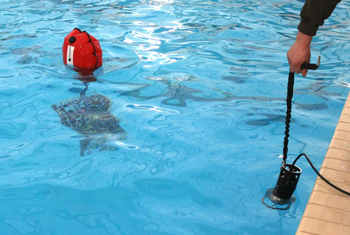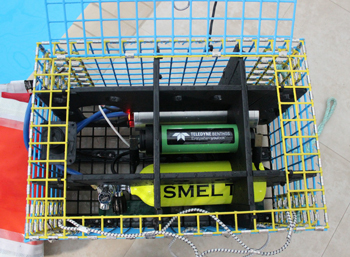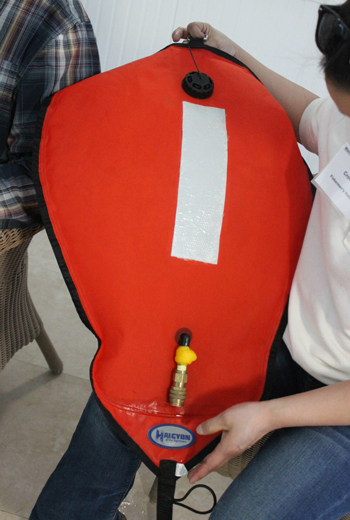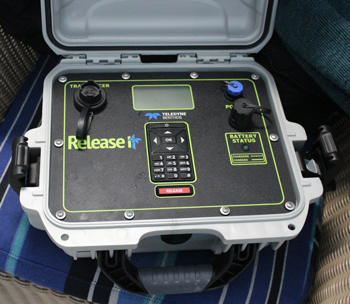Rope-less Lobster Raft Module
Demo at Forum

Swimming pool, Samoset Resort, Maine Fishermen’s Forum,
March 2, 2019. Remotely inflated bag lifting a Lobster Raft
containing an acoustic receiver, compressed air cylinder and hydraulic device. Black device at right sends the acoustic signal through the water to the acoustic receiver in the raft. Fishermen’s Voice photo.
Lawsuits filed by NGOs against NMFS regarding whale entanglements in fishing gear has had federal regulators and scientists scrambling for a solution. Where to start has been just one of the many questions. Last year Woods Hole Oceanographic Institute (WHOI) scientists were tasked with developing a rope-less system for getting lobster traps off the bottom without vertical lines between the trap and the buoy on the surface. These vertical lines are the latest target of non-governmental organizations and environmental groups suing the federal government for not doing enough under the Endangered Species Act to protect the North Atlantic right whale.
When West Coast marine engineer Richard Reils contacted the WHOI scientists to say he had been working on the problem for a number of years and had built a working prototype “they were very interested”, said Reils. “I built my first lobster raft module for $100.”

Lobster Raft rope-less lifting device. Bottom – yellow
pressurized air cylinder, center acoustic receiver and
signaling unit, top hydraulic device which opens the air
cylinder that fills the air lift bag. Raft weight can be varied
with conventional trap weights. Fishermen’s Voice photo.
That first model was used get Reils’ traps off the bottom. His latest model made with coated trap wire measures 24" X 16" X 12". It contains a gas cylinder, a hydraulic device that opens the gas cylinder and a sonar receiving unit that triggers the hydraulic device.
The weight of the module acts as an additional anchor. It is the first in a trawl line of traps. Acoustic signals between the module on the bottom and the surface control unit locate the module. Another signal triggers the hydraulic unit that releases gas from the cylinder to fill the bag. Currently there are two lift capacities, 80lbs. and 300lbs. This type of air bag lift technology has been around a long time, said Reils. It has been used to raise sunken ships, including among others the submarine Squalus off New Hampshire in 1939 and an attempt to raise the Andrea Doria off Massachusetts in 1956.

Inflated air bag with 80 lbs. of lift. The bag’s seams are ultrasonically welded. Pressure relief valves govern the speed of the lift bag up through the water column. Fishermen’s Voice photo.
Reils said, “Rope-less is not necessarily the solution. But it is on the route to a solution. If fishermen cannot fish, it is not a solution. Our module is a functional beginning to the development of a solution that might both reduce whale entanglements and could possibly be something fishermen find to be a better way to fish.”
Kevin Rand has worked with Reils in developing their system while fishing from Kevin’s boat on Stellwagen Bank off Cape Cod, Mass., where both he and Reils grew up. Reils and Rand have tested their module fishing from Rand’s boat with a recreational lobster license.
Mark Baumgartner is a scientist at WHOI who has worked for the last year in the development of rope-less trap technology. He’ll be testing equipment this summer, including Reils’, with fishermen. Baumbgartner said he considers this particular technology to be at the very beginning of development. A functional and affordable product, he said, was years away. There are spool and rope versions of this technology that have been developed for applications other than lobster traps.

Inflated air bag with 80 lbs. of lift. The bag’s seams are ultrasonically welded. Pressure relief valves govern the speed of the lift bag up through the water column. Fishermen’s Voice photo.
“Whatever the solution is it will need to be acceptable to all the parties involved. At this time that includes fishermen, NGOs, federal and state enforcement, the Endangered Species Act, scientists and equipment developers”, said Reils. “There are two important factors to consider,” said Reils. “There are two important factors to consider,” he said. “First, technology is constantly evolving. Looking at this as an evolving solution means that it will likely become incrementally better and less expensive over time. Second, meeting government requirements for a rope-less device is the single greatest cost driver.”
Reils said federal and state enforcement will require that rope-less gear be visible and accessible. Currently enforcement can see surface gear markers and haul gear to check the number of traps. Rope-less gear will have to be acoustically seen, acoustically triggered to be raised by an air bag, and hauled. He agreed fishermen cannot be expected to pay for the development of the device. Some funding is coming from NOAA. Other sources of funding may be the NGOs that are suing to facilitate an entanglement solution. Funded ocean data gathering by devices on board the lobster raft modules could become a revenue stream for some lobstermen, Reils said.
Rope-less is not
necessarily the solution.
But it is on the route
to a solution.
Now the only solution the government has is to close areas and fisheries. Reils said he is working to get the equipment built at no cost to fishermen. “Fishermen are not responsible for ending whale entanglement, but they have to do what is required by law. Fishermen cannot afford to do this if it is not subsidized by society,” said Reils. Several other species of whale become entangled in everything from rope to trash in the ocean in U.S waters and around the world. He said, “Whale entanglement is a societal problem. The high cost of developing new technology in the narrow timeframe the threat of extinction presents means the only solution is a societal response through government funding.”
Kevin Rand said he spoke with a lobsterman at the Maine Fishermen’s Forum in March 2019. Rand said the fisherman’s first words to him about the project were, “Just quit, don’t do it.” Rand offered to show him GoPro video of the raft module and an endline being lifted off the bottom. Another fisherman asked if the air bag could lift an anchor. He said that the fisherman who had said “quit” subsequently said, “It looks like you wouldn’t need an anchor with that raft on the bottom and you won’t need an endline or a buoy either.”
Rand said he has “chosen to take a middle position and avoid the extreme points of view on whale entanglement.” There is a lot of momentum behind the NGO lawsuits, the Endangered Species Act and the focus on the Northern Atlantic right whale. “Ropeless technology has been used by the U.S. Navy for years. I think we need to start with the problem and work toward a solution,” Rand said. Rope-less technology alone will not likely save the right whale, but the effort to develop it could be a part of what saves New England lobstermen.
